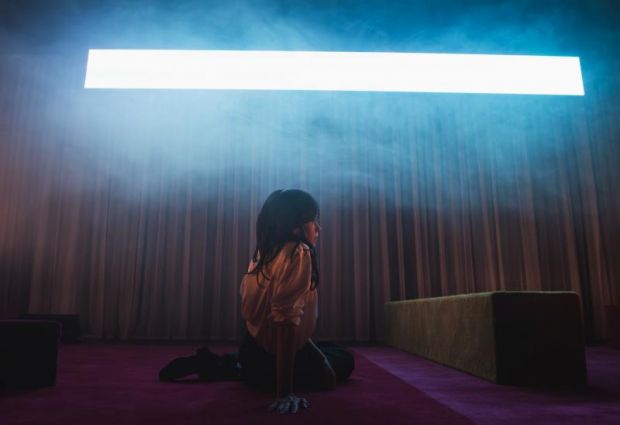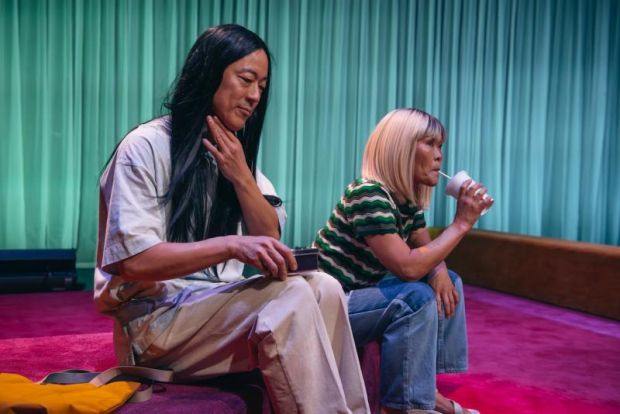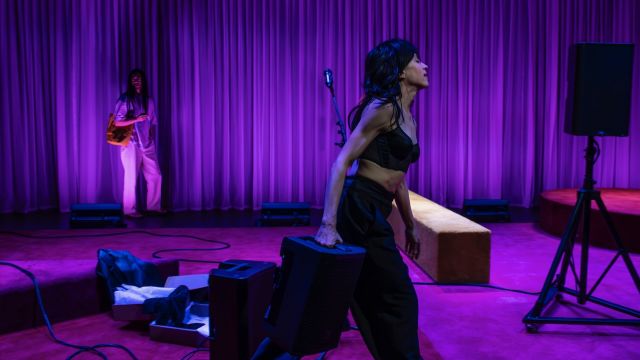Apologia
An ‘apologia’ is not an apology. On the contrary, it is a defence (written, spoken, passionate, logical, whatever) of one’s actions or beliefs. So what is Nicola Gunn defending here? It is the ambiguity of something is translated, transformed, recreated, replicated, copied, or incorporated into something else. What then is the nature or essential essence of the ur-thing that is translated, transformed and so on? What is its authenticity? (Some may recall the Abbas Kiarostami movie Certified Copy.)
Nicola Gunn, a true original, knows what she is doing – even if we may take a while to catch up – and she will give us whatever it is with great charm and elan.
Here, in Act I – or the first part – Nicola – or a version of Nicola – is alone in an empty sound studio. Her ambition is to be a French film actress in a French movie although she is not French and speaks no French. So she has engaged a French translator/advisor, Séverine (Séverine Magois) who is just a voice from a speaker. Meanwhile, the studio curtains keep changing colour and Nicola puts on and takes off various costumes as she and Séverine talk, via the microphone and speaker…

Nicola’s character in the movie is a translator and she figures she’ll only have to speak French part of the time, and she can learn the French dialogue phonetically, although she does not want to sound mechanical… But Séverine, who is something of an argumentative bully in the French style, does not find the story in the script very interesting and, to Nicola’s frustration and fury, hijacks the script with a (true?) story from her own life…
In Part 2, two Japanese tourists (Yumi Umiumare and Taka Takiguchi) sit and watch the construction/reconstruction of the Notre Dame cathedral spire using ‘traditional’ materials and methods. Will the ‘new’ spire – in fact, it’s the fifth – be authentic – and to what? Their dialogue is all in Japanese with an English translation in surtitles… So we think/assume they are Japanese – don’t we?

In the third part, Séverine’s (true?) story uncannily returns… There is a fourth part, in which the cast carry, raise, lower and rotate translucent discs which disappear and reappear and change colour. It (I think) about colour and light and coloured light. Which is the ‘true’ colour? Is the colour there when we can’t see it?
Is there a narrative thread through all this? No. Well, at a meta-level, yes. The four parts are ‘thematically linked’: all confront the same questions – true/false, authentic/fake, original/replica, etc.
In fact, the concept, once we grasp it, is rather simple (well, a bit less bewildering compared to some other Nicola Gunn creations), but Nicola Gunn is a genuine one-off – absurd yet clear – and Apologia is funny, surprising, inventive, very entertaining and it really does ask those questions for our contemplation.

The ironies of Nicola’s (actually ridiculous but why not?) plan versus Séverine’s preference for ‘truth’, the successive reveals of those Japanese tourists – who seem to know rather too much about the history of Notre Dame - and then what happens to Nicola’s movie script - all are quite delicious and delightful twists. If the show, in the end, seems to be in search of an ending, let alone a resolution, that is entirely in keeping with the concept of the whole thing – an apologia for contradictions.
Michael Brindley
Photographer: Gregory Lorenzutti
Subscribe to our E-Newsletter, buy our latest print edition or find a Performing Arts book at Book Nook.

